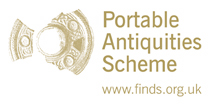File:Roman coin, reverse (FindID 79842).jpg
From Wikimedia Commons, the free media repository
Jump to navigation
Jump to search
Roman_coin,_reverse_(FindID_79842).jpg (507 × 566 pixels, file size: 224 KB, MIME type: image/jpeg)
File information
Structured data
Captions
Captions
Add a one-line explanation of what this file represents
Summary
[edit]| Roman coin, reverse | |||
|---|---|---|---|
| Photographer |
Northamptonshire County Council, Tom Brindle, 2004-11-05 12:07:37 |
||
| Title |
Roman coin, reverse |
||
| Description |
English: A copper-alloy Roman coin. This coin is an example of a rare sub-group of Trajan's aes coinage. They are probably from an eastern mint (often thought to be Antioch, but this is perhaps unnecessarily precise). The reverse, an S C in a laurel wreath, is associated with that mint, as is the bucranium (bulls-head) countermark. The coins are dated to circa 116 when Trajan was resident in Antioch. The denomination is not really known; although radiate and of oricalcum (brass) they are smaller than dupondii. RIC / BMC label them as asses, but they are labelled as semises by Metcalf (W E Metcalf, 'A note of Trajan's aes from Antioch', American Numismatic Society Museum Notes (1977) 22, 67). They may have circulated as semises (half asses) or as half-dupondii / oricalcum asses (the as was normally struck in copper).
Many examples of this type have a 'bucranium' (bulls-head) countermark like this one. There are 20 coins of this denomination at Bath, and one of them has the bucranium countermark. Outside of Syria these coins are only common in the N W provinces suggesting that they may have formed part of an official government consignment of coinage from the East (D R Walker, 'The Roman Coins' in B Cunliffe (ed.) The Temple of Sulis Minerva at Bath, Volume 2, The Finds from the Sacred Springs, Oxford 1988). The degree of wear (often worn flat, as here) suggests that they may have circulated for more than a century after their importation. |
||
| Depicted place | (County of findspot) Northamptonshire | ||
| Date | between 96 and 117 | ||
| Accession number |
FindID: 79842 Old ref: NARC-B683C2 Filename: NARC-B683C2semisrev.jpg |
||
| Credit line |
|
||
| Source |
https://finds.org.uk/database/ajax/download/id/41997 Catalog: https://finds.org.uk/database/images/image/id/41997/recordtype/artefacts Artefact: https://finds.org.uk/database/artefacts/record/id/79842 |
||
| Permission (Reusing this file) |
Attribution-ShareAlike License version 4.0 (verified 23 November 2020) | ||
| Other versions |
|
||
Licensing
[edit]This file is licensed under the Creative Commons Attribution-Share Alike 4.0 International license.
Attribution: The Portable Antiquities Scheme/ The Trustees of the British Museum
- You are free:
- to share – to copy, distribute and transmit the work
- to remix – to adapt the work
- Under the following conditions:
- attribution – You must give appropriate credit, provide a link to the license, and indicate if changes were made. You may do so in any reasonable manner, but not in any way that suggests the licensor endorses you or your use.
- share alike – If you remix, transform, or build upon the material, you must distribute your contributions under the same or compatible license as the original.
File history
Click on a date/time to view the file as it appeared at that time.
| Date/Time | Thumbnail | Dimensions | User | Comment | |
|---|---|---|---|---|---|
| current | 02:52, 25 January 2017 |  | 507 × 566 (224 KB) | Fæ (talk | contribs) | Portable Antiquities Scheme, WMID, FindID: 79842, roman, page 352, batch count 5336 |
You cannot overwrite this file.
File usage on Commons
The following 2 pages use this file:
Metadata
This file contains additional information such as Exif metadata which may have been added by the digital camera, scanner, or software program used to create or digitize it. If the file has been modified from its original state, some details such as the timestamp may not fully reflect those of the original file. The timestamp is only as accurate as the clock in the camera, and it may be completely wrong.
| JPEG file comment | LEAD Technologies Inc. V1.01 |
|---|


